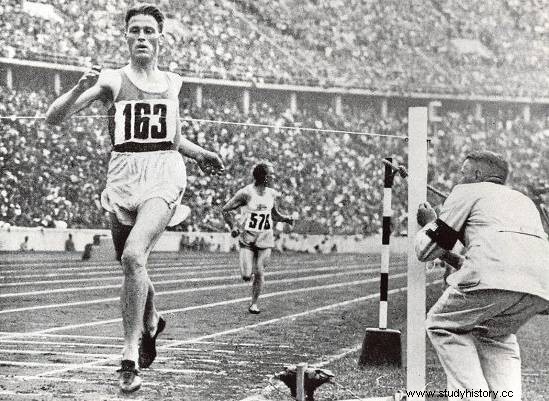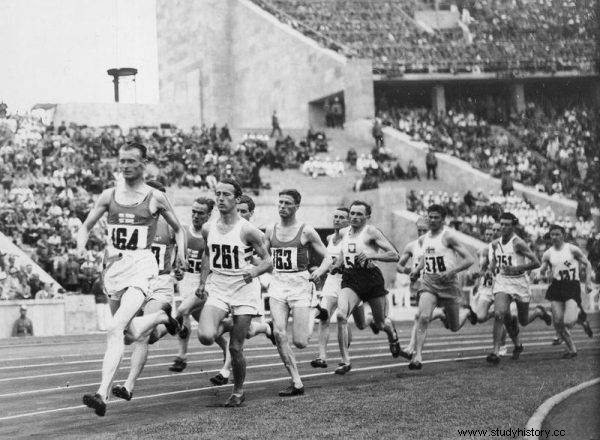Several years had to pass before the uniqueness of this Olympic final was noticed. In 1936 in Berlin, in front of Adolf Hitler, the following were in the competition:a Finnish army soldier, a Polish concentration camp prisoner, an American bombardier who drifted in the Pacific waters for 47 days, a soldier from Japan and an FBI agent.
August 7, 1936, Olympiastadion in Berlin. The large audience is waiting for the runners to start at the distance of 5000 meters. At stake is Olympic gold and eternal glory. The referee gives the signal to start. The pace has been dictated by the American Donald Lash from the very beginning. After two kilometers, however, he is caught by a group of three runners. Soon the race turns into a battle between Finns:Gunnar Höckert and Olympic champion Lauri Lehtinen. On the last lap, Höckert jumps away from Lehtinen and wins, setting the Olympic record at 14:22.2.
More competitors report to the finish line. The Swede Henry Jonsson is third. Kohei Murakoso from Japan and a Pole, Józef Noji, finished fourth and fifth. The disappointment of the Americans:Louis Zamperini and Don Lash - their eighth and thirteenth place respectively among the fans go unnoticed.
Several years have passed. In 1945 the Second World War ended and someone who closely followed the history of Olympism noticed that this final was extraordinary . And it is not about the strict aspect sports, and about the wartime fate of its participants.
Militia and Hero
The new Olympic champion, Gunnar Höckert, was born in February 1910 in Helsinki and grew up in a wealthy family:her mother, Emilia, worked in a bank, and her father was a consul. When he started training, he realized that it was in Finland that it would be really difficult to win great sports victories. In the 1920s and 1930s, this Scandinavian country developed a training system that guaranteed a steady supply of great medium and long-distance runners . It was almost a miracle to stand out in this gifted crowd. Perhaps that is why Gunnar did not neglect his studies while studying at the Swedish School of Economics in Helsinki.
It was 1936. Höckert, who had not yet achieved great results, suddenly "fired". He started to run fast. He was breaking records. The coaches decided that they would take him to the Olympic Games in Berlin. There, on August 4, he won the second elimination run over a distance of 5,000 meters, in 15:10.2. Three days later, he faced the greatest opportunity in his life. He used her.

Gunnar Höckert was the first to break the tape
A few weeks later, Gunnar set three more world records:at 2,000 and 3,000 meters and at 2 miles ... and disappeared. It turned out that rheumatism - a disease that the Finnish champion was struggling with - did not let him stop his promising career. Athletics have suffered a huge loss.
Gunnar Höckert did not let himself be forgotten. In the last days of November 1939, the USSR launched an attack on Finland. The Winter War has begun. The former runner volunteered for the army. For several weeks he bravely defended the borders of his homeland, but did not live to see the end of the conflict . On February 11, 1940, on the eve of his thirtieth birthday, Soviet bullets hit him in the Isthmus of Karelian. He died as a result of his injuries. In Finland he gained the status of a hero.
Lauri Lehtinen - a teammate, the same with whom Höckert fought for the triumph in 1936 - as soon as he found out about his rival's death from the track, he handed over his 1932 Olympic gold medal to the soldier who fought with Höckert. Thus, he commemorated the great athlete, friend and hero.
Józek, the phenomenon from Pęcków
In that race, Józef Noji was the fifth finishing line. Even before the Berlin Olympics, he was called the successor of Janusz Kusociński. A great, international career was foretold, but for him, a boy from Pęcków in Greater Poland, the great world was not very attractive.
He was born on September 8, 1909. He had to grow fat quickly because his father died of tuberculosis and the family was not among the richest. Józek was then eight years old. He combined education at a primary school with farm work and carpentry practice. He was known in Pęckowo for one more reason:he often ran. While today people jogging on sidewalks do not arouse much surprise, almost a hundred years ago such a sight was peculiar. Noji did not mind the squeamish teasing, even gaining an ally over time - mum .
On September 17, 1933, Józef stood at the starting line of the run organized by the editorial office of Kurjer Poznański. With his attitude, he surprised observers who could not understand how a self-taught man from a small town took second place, losing only to the best in Poland, Maksymilian Hartlik. After this performance, the runner's career gained momentum:he won big runs and repeatedly celebrated the titles of the national champion. He also went to Berlin and advanced to the aforementioned final.

The war interrupted his promising career. Józef Noji died in Auschwitz
After its completion, the editor of "Illustrated Daily Kuryer" caught him. The Olympian told him:
- I am very happy that I was able to rehabilitate at least in part after my terrible performance on Sunday (at 10,000 meters - ed.). Currently I feel great, although two days ago, during the run, I was not sure if I could achieve a better result than Kusociński's record. I have the impression that the only reason for my failure on Sunday was a terrible steak.
Anyway, this steak later became a synonym of an excuse accompanying the poor results of Polish athletes .
Józef's sports career, like many others, was interrupted by the war. After the September campaign, the runner worked in tram workshops. He was also active in the underground, which is why he was arrested in September 1940. The Germans offered him to sign the Volkslist twice. Refused. He came to Pawiak, and then - in July 1941 - to Auschwitz.
In the camp he worked as a carpenter. He was appreciated by his fellow prisoners and the guards who knew perfectly well who they were dealing with . The strong organism behind which the sport practiced earlier fought typhus, endured beatings, and helped to survive. But on February 15, 1943, the phenomenon from Pęcków faced death. Before the shots were fired in his direction, he had to shout:
- Poland is not dead yet!
He was another contestant in this final who did not survive the war.
Drifting in the ocean
Not the Olympic champion, Höckert, not Józef Noji, murdered in Auschwitz, but the eighth-finisher of the American - Louis Zamperini - is the best-known participant in the race. And again not because he was an outstanding athlete, but because of his wartime history. A story that even got Hollywood production.
Zamperini was considered a difficult kid. Born in January 1917, he often got into fights with his peers. All because of the Italian origin and the persecution related to it. For teenage Louis, aggression and a rebellious nature became a means of survival. They could also lead him to jail. Fortunately, Pete - his brother - persuaded him to train in athletics. The young man caught the bug and in 1934 he set the world record for high schools in the mile run.
In 1936 he qualified for the Olympic team. He made it through the elimination and on August 7, 1936 he fought for the Olympic championship. He did not win the title, but his spectacular, long finish on the last lap went down in history . Reportedly, he made up 46 meters to his rivals. It did not escape the attention of Adolf Hitler, who was supposed to shake his hand and say:
- Ah, you are that young man with a quick finish!
Years later, Louis summed up the meeting with the words:
- In 1936 we still considered Hitler merely a dangerous jester.

During the war, Louis Zamperini fought in the Pacific. He was captured by the Japanese
In May 1943, less than six years after that meeting, the Olympian boarded the B-24 "The Green Hornet". He was a soldier who fought Hitler and his Japanese allies. This time he was supposed to help colleagues. The flight turned out to be tragic. The defective machine crashed into the Pacific, and eight of the eleven crew members were killed. The remaining three (later two), including Louis, drifted on a raft for 47 days in the waters of the Pacific Ocean . Then Zamperini was taken prisoner by Japan, where, until August 1945, he was treated inhumanly. However, he survived the war, and based on his fate, the film "Unbreakable", directed by Angelina Jolie, was released in cinemas in 2014.
FBI agent and Japanese soldier
This is not the end of the Berlin middle-distance ties to the war. The fourth one, Kohei Murakoso, went to the Imperial Japanese Army, where he achieved the rank of captain. He fought the Americans. The thirteenth Donald Ray, who set the pace of the competition for the lion's share of the final, became an FBI agent during World War II. Two days before the United States declared war on Japan, Don and another agent broke into the apartment of an alleged German spy in Atlanta . They took the notebook, and the notes contained in it helped in his arrest and in obtaining information about other secret agents of the Third Reich, staying on the territory of the USA.

Olympic final at 5000 m. Józef Noji is visible in the middle of the field.
The other participants of the Olympic finals in 1936 were not so affected by the war. What's more, when Höckert, Noji and Zamperini were struggling with the difficult everyday life, some of their rivals from the treadmill were still running. She broke records. Only they had the opportunity…
